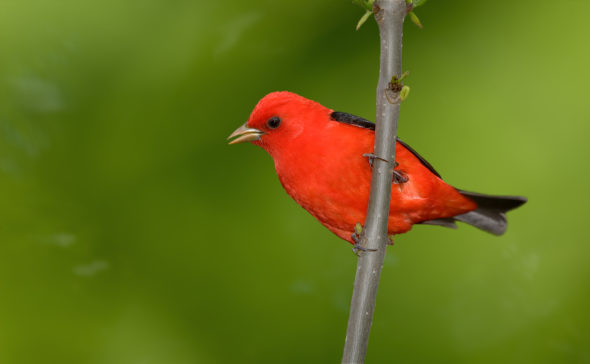
A male scarlet tanager in brilliant summer plumage. One scarlet tanager (in subdued winter plumage) was spotted in the local Christmas Bird Count, held Dec. 16. Results of that count were recently announced. (Photo via Wikipedia)
You said how many birds??
- Published: January 16, 2018
The local Christmas Bird Count results are in!
Local birding enthusiasts fanned out across area parks, wetlands and beyond on Dec. 16, with the mission of counting and identifying every bird they saw. Participants found 4,180 birds, representing 60 species.
Those numbers are “fairly typical,” according to local count organizer Nick Boutis, executive director of Glen Helen.
Most unusual species? Easily the scarlet tanager and house wren, Boutis said. One of each was spotted, in John Bryan State Park and Phillips Park (in Beavercreek), respectively. The scarlet tanager, a brilliant bird of the summer woods, is less obvious in the winter, when males’ plumage subdues to olive green and yellow. While both species breed here in the summer, they migrate out of our area in the fall.
Most numerous, surprising no one, were the ubiquitous European starling and Canada goose. Local favorites among the “big birds” included two great blue herons and 34 sandhill cranes. Sandhill cranes are a newcomer to our skies in the past 10 years, and the local bird count reflects that change, according to Boutis in a previous interview with the News.
This was the eighth year the Glen and local birders have participated in the Christmas Bird Count, an annual early-winter census of the birds of the Western Hemisphere organized by the Audubon Society. (Read an account of the 2015–16 local count here.) Tens of thousands of people across mostly North America count birds over the Christmas season in their local areas. The data from our Greene County count is pooled with those numbers to develop a long-term picture of the health of bird populations in our hemisphere.
And that data is helping to document the effects of climate change and other threats to birds. According to the Audubon’s 2014 Climate Change report, more than half of the 588 North American bird species are losing their climatic range.
The final tally of species from the Greene County bird count follows:
|
Great Blue Heron |
2 |
|
Turkey Vulture |
1 |
|
Black Vulture |
7 |
|
Canada Goose |
519 |
|
Wood Duck |
3 |
|
Mallard |
6 |
|
Northern Pintail |
2 |
|
Sharp-shinned Hawk |
1 |
|
Cooper’s Hawk |
3 |
|
Red-shouldered Hawk |
1 |
|
Red-tailed Hawk |
10 |
|
Sandhill Crane |
34 |
|
Rock Pigeon |
8 |
|
Mourning Dove |
36 |
|
Eastern Screech-Owl |
1 |
|
Belted Kingfisher |
6 |
|
Red-headed Woodpecker |
2 |
|
Red-bellied Woodpecker |
58 |
|
Yellow-bellied Sapsucker |
3 |
|
Downy Woodpecker |
69 |
|
Hairy Woodpecker |
6 |
|
Northern Flicker |
36 |
|
Pileated Woodpecker |
4 |
|
Eastern Phoebe |
2 |
|
Blue Jay |
58 |
|
American Crow |
422 |
|
Horned Lark |
15 |
|
Carolina Chickadee |
176 |
|
Tufted Titmouse |
73 |
|
Red-breasted Nuthatch |
4 |
|
White-breasted Nuthatch |
75 |
|
Brown Creeper |
9 |
|
Carolina Wren |
75 |
|
Winter Wren |
1 |
|
Golden-crowned Kinglet |
25 |
|
Eastern Bluebird |
50 |
|
Hermit Thrush |
6 |
|
American Robin |
244 |
|
Northern Mockingbird |
1 |
|
European Starling |
1295 |
|
Cedar Waxwing |
15 |
|
Eastern Towhee |
8 |
|
American Tree Sparrow |
24 |
|
Field Sparrow |
3 |
|
Fox Sparrow |
4 |
|
Song Sparrow |
97 |
|
Swamp Sparrow |
4 |
|
White-throated Sparrow |
133 |
|
White-crowned Sparrow |
6 |
|
Dark-eyed Junco |
107 |
|
Northern Cardinal |
98 |
|
Red-winged Blackbird |
1 |
|
Common Grackle |
2 |
|
House Finch |
41 |
|
Pine Siskin |
1 |
|
American Goldfinch |
119 |
|
House Sparrow |
66 |
|
Scarlet Tanager |
1 |
|
Blackbird |
100 |
|
House Wren |
1 |
| Total |
4180 |
The Yellow Springs News encourages respectful discussion of this article.
You must login to post a comment.
Don't have a login? Register for a free YSNews.com account.













No comments yet for this article.